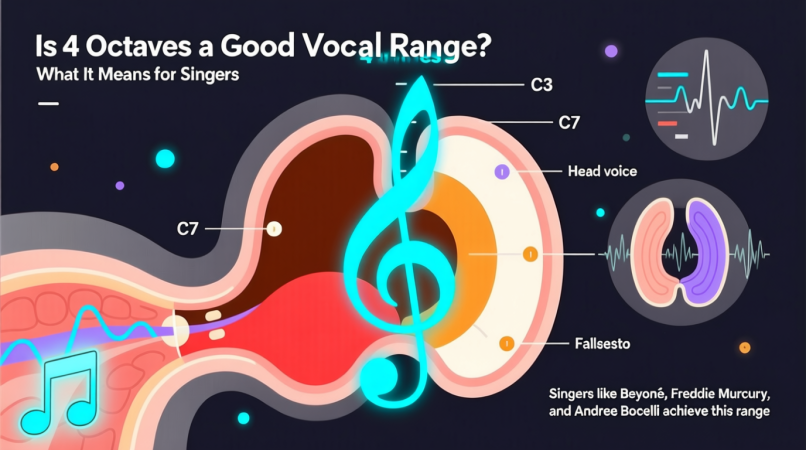
Vocal range is one of the most talked-about aspects of singing. Some artists are praised for hitting extremely high or low notes, while others captivate audiences with tone and control, regardless of their range. So, if you can sing across four octaves, is that considered good? Let’s break it down with examples, comparisons, and practical advice.
What Exactly Is a 4-Octave Vocal Range?
An octave is the distance between one note and the next note of the same name, either higher or lower in pitch. For example, from C3 to C4 is one octave.
A four-octave range spans a wide section of the piano—about half of its 7.25 octaves. If your range is from C2 to C6, that’s four octaves. Some singers achieve this with the help of whistle tones or subharmonics, while others naturally sit in a broad range.
It’s important to separate:
- Maximum range: The absolute highest and lowest notes you can produce, even if weak.
- Usable range: The notes you can sing clearly, consistently, and with control.
A true, usable four-octave span is rare—and extraordinary.
How Does 4 Octaves Compare to Average Singers?
Most people don’t realize how unusual four octaves is. Here’s a breakdown:
- Untrained singers: Usually between 1.5 and 2 octaves.
- Trained singers: Often between 2.5 and 3 octaves.
- Professional outliers: Some reach 4, 5, or even more octaves, though few use the entire range in performance.
So yes, four octaves is considered very good. It puts you well above the average, even among trained vocalists.
👉 Curious where your voice sits? You can check your vocal span here with this range test tool.
Famous Singers With 4 Octaves or More
Very few singers are confirmed to have a usable four-octave range, but some examples include:
- Mariah Carey – Famous for her whistle register, reportedly spans five octaves.
- Axl Rose – Often cited with a massive range from deep lows to piercing highs.
- Freddie Mercury – Close to four octaves, known for dramatic vocal shifts.
- Yma Sumac – Claimed to have 5 octaves, with recordings that support a huge span.
These artists show that a large range can contribute to a signature style—but they also relied on tone, artistry, and interpretation, not just raw range.
Is 4 Octaves Always an Advantage?
Having four octaves opens many possibilities, but it’s not always about hitting the extremes.
The Benefits
- Flexibility: You can sing across many genres, from low bluesy tones to high pop runs.
- Expression: More notes mean more options for dramatic effect.
- Uniqueness: Few singers can claim this span, so it can set you apart.
The Challenges
- Consistency: Maintaining the same tone across the full range is difficult.
- Stamina: Using your full range often can be tiring.
- Risk of strain: Pushing too far into extremes without proper technique can cause damage.
Range vs. Tone: Which Matters More?
While a four-octave range sounds impressive, audiences often care more about tone, emotional delivery, and control. Many world-class singers, like Frank Sinatra or Ed Sheeran, succeed with modest ranges of 2–2.5 octaves.
In fact, most popular songs fall within just one to two octaves. A beautiful voice that conveys emotion will always connect more deeply than extreme high notes sung without control.
Visualizing the Difference
| Vocal Range | Span | Singer Example | Notes |
|---|---|---|---|
| 2 octaves | Average | Most casual singers | Covers most songs |
| 3 octaves | Above average | Adele, Elton John | Versatile |
| 4 octaves | Exceptional | Freddie Mercury, Axl Rose | Rare and powerful |
| 5+ octaves | Extreme | Mariah Carey, Yma Sumac | Very rare, whistle register |
This comparison shows why 4 octaves is considered exceptional but not essential.
Can You Train for 4 Octaves?
Yes, but it takes time and safe technique. Very few people naturally start with four octaves. Most expand their range gradually.
Training Tips
- Warm-ups: Gentle scales and sirens to stretch gradually.
- Register blending: Practice transitions between chest, head, and falsetto.
- Breathing support: Control airflow for consistent tone.
- Incremental practice: Expand by semitones, not leaps.
- Professional guidance: A vocal coach can prevent strain.
👉 As you practice, you can track your development using this vocal range calculator.
Common Myths About Vocal Range
- “Bigger is always better.” Not true—usable range matters more.
- “Only professionals can reach 4 octaves.” Some trained amateurs can too.
- “You need 4 octaves to succeed.” Many global stars thrived with smaller ranges.
- “Falsetto doesn’t count.” It does, as long as it’s controlled and musical.
FAQs About 4 Octaves
Is 4 octaves a good vocal range?
Yes—four octaves is rare and impressive, though consistency matters more than extremes.
How many singers have 4 octaves?
Very few; most professionals have 2.5–3.5 usable octaves.
Is it possible to train up to 4 octaves?
With practice and safe technique, some singers expand their range over time.
Who has the widest vocal range in history?
Yma Sumac and Tim Storms are often mentioned, spanning more than 5 octaves.
Do you need 4 octaves to be successful?
Not at all. Success depends more on tone, style, and artistry.
